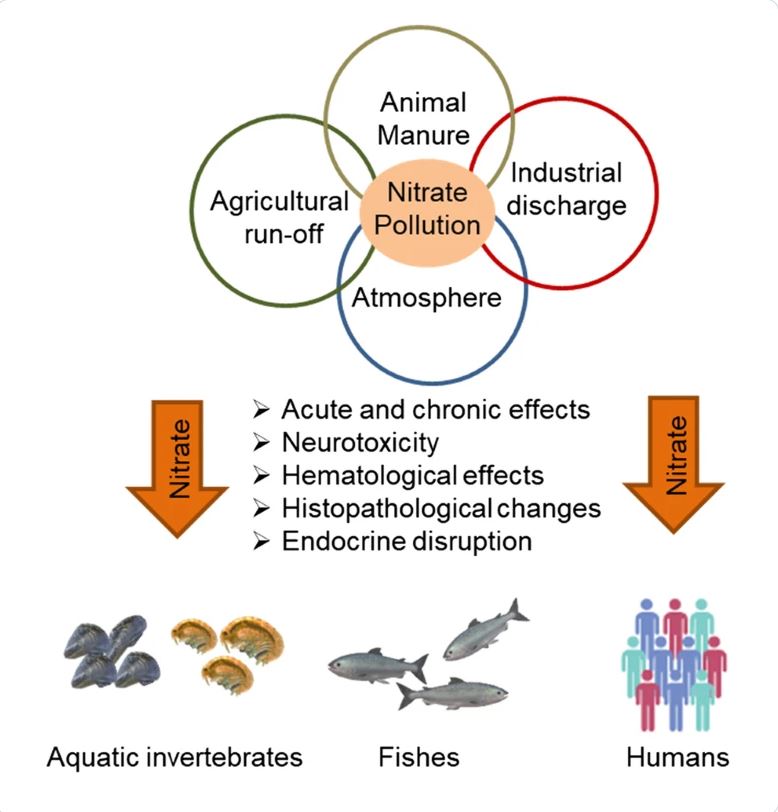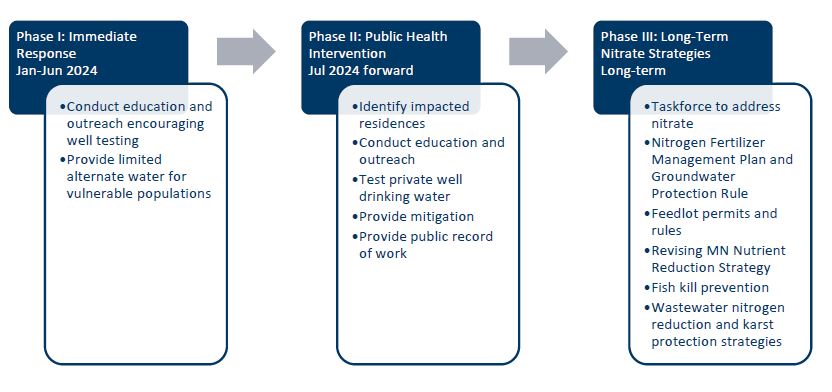Nitrate Contamination

Nitrates reduce the size and potentially survival of trout populations. Nitrates act as nutrient enrichment which can lead to algal blooms, oxygen depletion, and a general deterioration of trout habitat. Increased nitrates in streams can lead to decreased suitability of habitat, especially for spawning and nursery areas, stress on adult fish which can make them more susceptible to disease and impact their reproductive success,and have been shown to decrease the number of aquatic insects available as a trout food. (Gomez, 2020; Banerhee, 2023) There are human health impacts as well. Nitrate-contaminated water causes infant methemoglobinemia, or “blue baby syndrome,” a serious health hazard for young children. Additionally, nitrate-contaminated water has been connected to other diseases, including diabetes and colorectal cancer. (MCEA, 2023)
Where do nitrates come from?
Nitrates come from a variety of sources, both natural and human based, but we know agricultural runoff and livestock manure are the primary sources. In fact, 90% of nitrate in southeastern Minnesota’s waters comes from fertilized croplands. (MPCA, 2013) Southeastern Minnesota, often called the Driftless or Karst Region, is a unique landscape dominated by porous limestone that makes it especially susceptible to groundwater contamination. Water can move rapidly from the surface to groundwater through fractures and conduits in the limestone rock. Groundwater emerges from the springs common in this landscape. They are the source for the coldwater streams anglers look for, but also provide a direct conduit from the surface to groundwater aquifers for pollutants like nitrates.
How can we prevent nitrate pollution?
Nitrate pollution can be prevented in several different ways. Minnesota’s Groundwater Protection Rule restricts the application of nitrogen fertilizer in the fall and on frozen soils. Additionally, encouraging farmers to grow cover crops in fall means that excess nitrogen can be retained. Restricting the number of animals in a feedlot is important for manure management, another major source of nitrates. In addition to sustainable agriculture and feedlot practices, wetlands can play a role in filtering nitrates. Minnesota’s Buffer Law requires that landowners maintain perennial vegetation within 50 feet of waterways on average, and 35 feet at a minimum. The habitat work that Minnesota Trout Unlimited does along streams, creating wide, vegetated benches, not only reconnects the floodplain, but is a critical contribution to preventing nitrates from entering streams. Education and outreach, collaboration and open communication between farmers, agencies, and organizations, and long-term monitoring of the surface and groundwater is important. Additionally, we need to continue to develop policies that provide incentives to manage and use land with a focus on water quality and codify regulations that prevent nitrate pollution.
How is MNTU Taking Action?
In April of 2023, Minnesota Trout Unlimited and ten partner organizations, including the Minnesota Center for Environmental Advocacy (MCEA), submitted a petition to the Environmental Protection Agency (EPA). The petition requested the EPA use its emergency powers, through the Safe Drinking Water Act, to demand that the Minnesota Departments of Health (MDH) and Agriculture (MDA), and the Minnesota Pollution Control Agency (MPCA) address the worsening groundwater nitrate contamination in the eight-county Karst Region of southeast Minnesota. The EPA responded to the petition in November, demanding a work plan from the state agencies describing how they would take “timely actions to address the nitrate contamination, especially with respect to providing public notice and alternate water.” (Shore, 2023)
On January 12, 2024, the MDH, MDA and MPCA responded to the EPA request with a work plan that includes the three phases shown in the graphic.

Early assessment by MCEA, MNTU’s partner and the lead petitioner, is that the plan does not demonstrate that the state is using “all available tools to hold the sources of nitrate pollution accountable.” Representative Rick Hansen, Chair of the House Environment and Natural Resources Finance and Policy Committee, called it “embarrassing” and not the response that is needed to respond to the “public health crisis” we are currently in. (Stanley, 2024)
Nitrates are not the only thing that is contaminating our streams. Insecticides, including neonicotinoids, and fungicides are other major chemicals to mention. Their application on fields, as well as inadequate manure management from feedlots, compounded by the increased heavy rainfall events we are seeing be[1]cause of climate change, create extra challenges. A recent legislative report, “Preventing fish kills in Minnesota’s driftless region.” (2024), promotes some of the critical action we need now, and underscores the EPA’s demand that our agencies do better.
On January 28, 2025, Minnesota Trout Unlimited joined the Minnesota Center for Environmental Advocacy (MCEA) and the Minnesota Well Owners Association (MNWOO) in a lawsuit against the Minnesota Pollution Control Agency and Minnesota Department of Agriculture to compel them to do a better job of protecting coldwater ecosystems from harm caused by high nitrate levels and fish kills. You can read more about the lawsuit here.
What’s Next?
Stay tuned for opportunities during the 2025 legislative session.
Sign up for our regular action alerts to get involved!
LEARN MORE!
Banerjee, Priyajit, et al. “A critical review on the effect of nitrate pollution in aquatic invertebrates and fish.” Water, Air, & Soil Pollution, vol. 234, no. 6, 17 May 2023, https://doi.org/10.1007/ s11270-023-06260-5.
Gomez Isaza, Daniel, et al. “Living in polluted waters: A meta-analysis of the effects of nitrate and interactions with other environmental stressors on freshwater taxa.” Environmental Pollution, vol. 261, June 2020, p. 114091, https:// doi.org/10.1016/j.envpol.2020.114091.
Minnesota Center for Environmental Advocacy “Drinking Water in MN’s Karst Region Is at Risk.”, www.mncenter.org/karst-video. Accessed 22 Jan. 2024.
Press, The Associated. “Latest EPA Assessment Shows Almost No Improvement in River and Stream Nitrogen Pollution.” MPR News, MPR News, 22 Jan. 2024, www.mprnews.org/story/2024/01/22/latest-epa-assessmentshows-almost-no-improvement-in-riverand-stream-nitrogen-pollution.
Shore, Debra, Regional Administrator & Great Lakes National Program Manager. “Environmental Protection Agency Response to Petition That the U. S. Environmental Protection Agency Exercise Its Emergency Powers under Section 1431 of the Safe Drinking Water Act (SDWA) to Address Groundwater Nitrate Contamination That Presents a Risk to the Health of the Residents in Eight Counties of the Southeast Karst Region2.” Received by Dr. Cunningham, Mr. Peterson, and Ms. Kessler, 3 Nov. 2023.
Stanley, Greg. “State Says It Will Provide Clean Drinking Water in Southeast Minnesota but Offers No New Curbs on Farm Pollution.” Star Tribune, 17 Jan. 2024, www.startribune.com/stateto-clean-drinking-water-in-southeastminnesota-but-offers-no-new-steps-tocurb-farm-pollution/600336428/?refres h=true.
Work Plan: Addressing Nitrate in Southeast Minnesota – MN Dept. of Health, MN Dept. Of Ag, MN PCA www.health. state.mn.us/communities/environment/ water/docs/wells/waterquality/epaworkplan.pdf. Accessed 22 Jan. 2024.
Environmental Protection Agency Response to petition that the U. S. Environmental Protection Agency exercise its emergency powers under Section 1431 of the Safe Drinking Water Act (SDWA) to address groundwater nitrate contamination that presents a risk to the health of the residents in eight counties of the Southeast Karst Region2
